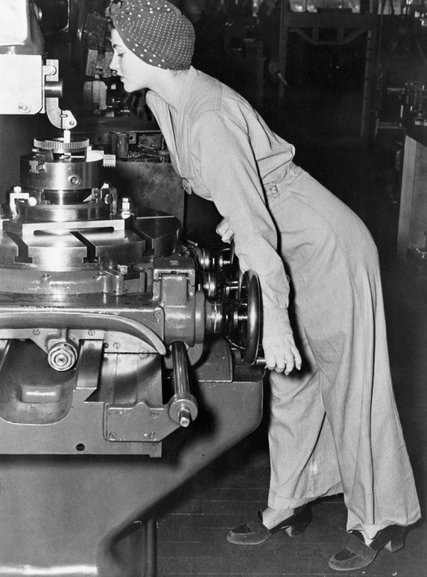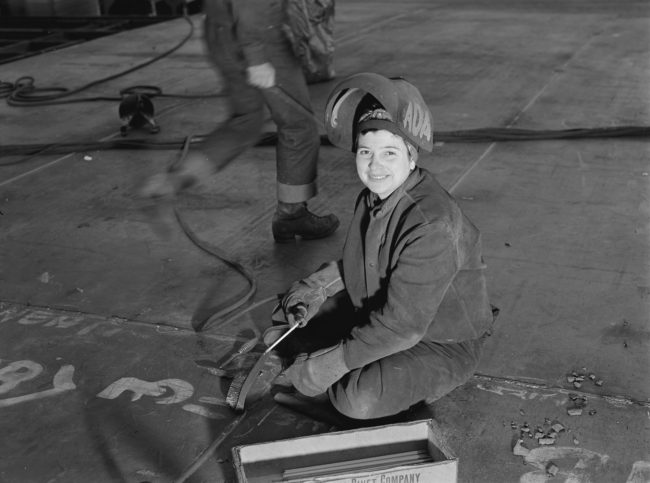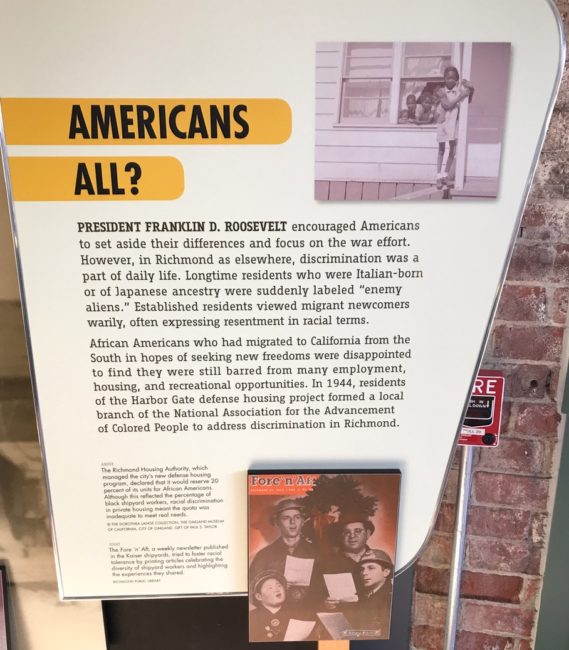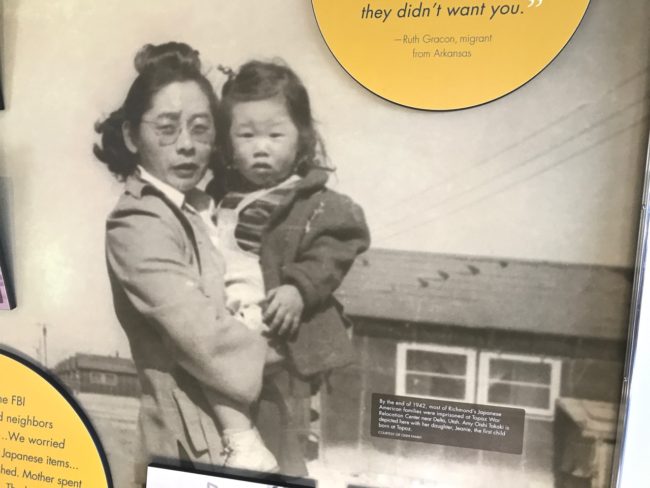
Petaluma Adobe State Historic Park/Vallejo’s Petaluma Adobe – Petaluma
February 28, 2018
Jet Propulsion Laboratory (JPL) Tour – Pasadena/La Cañada Flintridge
April 2, 2018I Am Woman!
 Rosie the Riveter/World War II Home Front National Historical Park – Richmond
Rosie the Riveter/World War II Home Front National Historical Park – Richmond
Visited: February 2018
On a drive from Southern California to Bodega Bay, our route took us over the San Rafael Bridge. We diverted a few exits short of the bridge to check out a museum I had recently heard about from our friend Kim … the Rosie the Riveter/World War II Home Front National Historical Park in Richmond (in the East Bay region of the San Francisco Bay Area).
 During World War II, when there became such a drastic shortage of available men to fill the workplace, companies realized they would have to finally change their hiring practices by employing women, minorities, older men and people with disabilities. For many, this was their first employment. According to the Encyclopedia of American Economic History, “Rosie the Riveter” inspired a social movement that increased the number of working American women from 12 million to 18 million by 1944.
During World War II, when there became such a drastic shortage of available men to fill the workplace, companies realized they would have to finally change their hiring practices by employing women, minorities, older men and people with disabilities. For many, this was their first employment. According to the Encyclopedia of American Economic History, “Rosie the Riveter” inspired a social movement that increased the number of working American women from 12 million to 18 million by 1944.
At the beginning of the war, four Richmond shipyards were built along the waterfront. The shipyards employed thousands of those previously disenfranchised workers. According to the National Park Service, “Kaiser’s Richmond shipyards built 747 Victory and Liberty ships for the war effort, more than any other site in the United States.” (ship photo courtesy of Richmond Museum of History).
By 1943, a song about Rosie the Riveter was popular, and Norman Rockwell painted a famous version of her (it appeared on the cover of The Saturday Evening Post). Many of these “Rosie The Riveters” took jobs as welders, electricians, carpenters and mechanics.
 Quick Digression: Tracy told me that the original Rosie the Riveter had recently passed away. As it turns out, the inspiration for “the actual Rosie the Riveter” had been a California waitress, Naomi Parker Fraley, who had worked at a California plant (she died in January of this year). This was not the “Rockwell Rosie.” There will be a quiz. Rosie’s most famous image is on a “We Can Do It” poster produced by J. Howard Miller in 1943 for Westinghouse Electric. It served as an “inspirational image” to boost worker morale. (photos of Naomi from NY Times)
Quick Digression: Tracy told me that the original Rosie the Riveter had recently passed away. As it turns out, the inspiration for “the actual Rosie the Riveter” had been a California waitress, Naomi Parker Fraley, who had worked at a California plant (she died in January of this year). This was not the “Rockwell Rosie.” There will be a quiz. Rosie’s most famous image is on a “We Can Do It” poster produced by J. Howard Miller in 1943 for Westinghouse Electric. It served as an “inspirational image” to boost worker morale. (photos of Naomi from NY Times)
 According to the Times, “After the Japanese attack on Pearl Harbor, the 20-year-old Naomi and her 18-year-old sister, Ada (below in a 2016 photo), went to work at the Naval Air Station in Alameda.”
According to the Times, “After the Japanese attack on Pearl Harbor, the 20-year-old Naomi and her 18-year-old sister, Ada (below in a 2016 photo), went to work at the Naval Air Station in Alameda.”
 “They were assigned to the machine shop, where their duties included drilling, patching airplane wings and, fittingly, riveting. It was there that the Acme photographer captured Naomi Parker, her hair tied in a bandanna for safety, at her lathe. She clipped the photo from the newspaper and kept it for decades.” The rest, as they say, is “herstory.” Well, I guess nobody really says that.
“They were assigned to the machine shop, where their duties included drilling, patching airplane wings and, fittingly, riveting. It was there that the Acme photographer captured Naomi Parker, her hair tied in a bandanna for safety, at her lathe. She clipped the photo from the newspaper and kept it for decades.” The rest, as they say, is “herstory.” Well, I guess nobody really says that.
 A short distance off I-580, on a picture perfect Northern California day, Tracy and I stopped to check out the museum dedicated to the workers who helped in the war effort. We were excited because I had just received my Senior National Park Pass that affords me lifetime entrance to United States national parks for free. At the ticket office, I was told this museum is “free” to everyone.
A short distance off I-580, on a picture perfect Northern California day, Tracy and I stopped to check out the museum dedicated to the workers who helped in the war effort. We were excited because I had just received my Senior National Park Pass that affords me lifetime entrance to United States national parks for free. At the ticket office, I was told this museum is “free” to everyone.
They must have known I was coming.
 After an overview from one of the docents (they are all very nice and informative, plus on many Fridays some of the “Real Rosies” are on hand to answer your questions). The facility also shows a short movie talking about its history, but we were a little short on time.
After an overview from one of the docents (they are all very nice and informative, plus on many Fridays some of the “Real Rosies” are on hand to answer your questions). The facility also shows a short movie talking about its history, but we were a little short on time.
 Rosie is prevalent everywhere.
Rosie is prevalent everywhere.
The shipyards also employed Wendy The Welder (alliteration must have been big in the ‘40s). Photo courtesy of the Library of Congress.
 Obviously the guy on the left didn’t get the memo on how to pose … he’s also not handy with a wrench (or any other tool for that matter).
Obviously the guy on the left didn’t get the memo on how to pose … he’s also not handy with a wrench (or any other tool for that matter).
 Different exhibits explained not only about the work they did, but how society felt in that era. We read that in 1936, “82% of Americans believed that a wife should not work if her husband had a job.”
Different exhibits explained not only about the work they did, but how society felt in that era. We read that in 1936, “82% of Americans believed that a wife should not work if her husband had a job.”
 Other exhibits displayed the hard work …
Other exhibits displayed the hard work …
 … all these people did during the war. There were lots of wartime posters, too.
… all these people did during the war. There were lots of wartime posters, too.
After a long day at the factory, here was a dinnertime favorite.
 The Ford Motor Company Assembly Plant is located next door, and during World War II it produced nearly 50,000 jeeps. These “Crated Jeeps” were assembled here, test driven, and then partly disassembled so they could be packed in crates and shipped to military units around the world.
The Ford Motor Company Assembly Plant is located next door, and during World War II it produced nearly 50,000 jeeps. These “Crated Jeeps” were assembled here, test driven, and then partly disassembled so they could be packed in crates and shipped to military units around the world.
 Videos touted the the work these “girls” could do.
Videos touted the the work these “girls” could do.
With the influx of workers, in 1943 Richmond was (as a sign stated) “A Swinging City,” with pool halls, dance halls, bowling alleys and a ballroom that held more than 250 who could dance the night away. However, “many venues remained segregated during the war” … including the local USO Club (the KKK had been active here through the 1920s).
 An entire “set” had been constructed at the museum …
An entire “set” had been constructed at the museum …
… to showcase the facets of daily life in 1940s Richmond.
 Nothing says a “fun night out on the town” more than attending an event featuring land mines, bazookas and flame throwers. I’m guessing many of the spectators got tanked.
Nothing says a “fun night out on the town” more than attending an event featuring land mines, bazookas and flame throwers. I’m guessing many of the spectators got tanked.
 In an adjoining room, there were more historical posters.
In an adjoining room, there were more historical posters.
Oh, and if you didn’t ride-share, it was tantamount to riding with this evil guy.
 Mobility in seeking other employment was not encouraged.
Mobility in seeking other employment was not encouraged.
 Racism during this period is definitely not overlooked at this museum.
Racism during this period is definitely not overlooked at this museum.
 African Americans weren’t the only ones discriminated against here in the early ‘40s. If you were Japanese … and were not already in an internment camp …
African Americans weren’t the only ones discriminated against here in the early ‘40s. If you were Japanese … and were not already in an internment camp …
 …you had to do some unthinkable things to survive (below).
…you had to do some unthinkable things to survive (below).
 Working at these jobs was not only difficult … but dangerous. A January 1944 issue of the New York Times said there had been 37,600 on-the-job deaths in the United States since Pearl Harbor, with more than 200,000 additional people becoming “permanently disabled” and 4.5 million “temporarily disabled.”
Working at these jobs was not only difficult … but dangerous. A January 1944 issue of the New York Times said there had been 37,600 on-the-job deaths in the United States since Pearl Harbor, with more than 200,000 additional people becoming “permanently disabled” and 4.5 million “temporarily disabled.”
 … as predicted, many workers were let go so returning soldiers could gain employment, but women had now found a voice. Said one, “The shipyard days gave women a whole new outlook on life: that I am an individual and I am important, and I can earn my own living.”
… as predicted, many workers were let go so returning soldiers could gain employment, but women had now found a voice. Said one, “The shipyard days gave women a whole new outlook on life: that I am an individual and I am important, and I can earn my own living.”
 In many ways, these Rosie The Riveters across the country who were able to find employment after the war (many women did not) were the genesis of the Equal Rights movement. Below are statements from a Michigan and California “Rosie.”
In many ways, these Rosie The Riveters across the country who were able to find employment after the war (many women did not) were the genesis of the Equal Rights movement. Below are statements from a Michigan and California “Rosie.”
Not too far from the museum is the SS Red Oak Victory, the last surviving ship built in the Kaiser Richmond Shipyards. It’s closed on Fridays … the day we visited (picture is from website). The ship remained active through the Korea and Vietnam wars.
 Our quick Rosie the Riveter tour was over, and we had learned a great deal in a short amount of time at this little gem of a museum complete with a picturesque waterfront locale (there’s a restaurant next door where you can grab a bite). I’d highly recommend a visit when in the vicinity.
Our quick Rosie the Riveter tour was over, and we had learned a great deal in a short amount of time at this little gem of a museum complete with a picturesque waterfront locale (there’s a restaurant next door where you can grab a bite). I’d highly recommend a visit when in the vicinity.
 As we were about to exit the building, I saw a Rosie posing for a photo who looked quite familiar.
As we were about to exit the building, I saw a Rosie posing for a photo who looked quite familiar.
 I said, “This is great, now I don’t have to call a plumber anymore … you can do it!” Fortunately, Tracy didn’t make me walk all the way to Bodega Bay. I’m glad she has a “Rosie” disposition.
I said, “This is great, now I don’t have to call a plumber anymore … you can do it!” Fortunately, Tracy didn’t make me walk all the way to Bodega Bay. I’m glad she has a “Rosie” disposition.
Rosie the Riveter/WWII Home Front National Historical Park
1414 Harbour Way South #3000
Richmond, CA 94804
Hours: Daily 10 a.m. – 5 p.m.
Phone: 510.232.5050
Cost: Free
Parking: Free
Rosie Meet and Greets
Most Fridays, a group of civilian WWII docents share their stories in an informal setting at the Visitor Center. Here is your chance to ask the experts—real Rosies from the Kaiser shipyards—about life and work on the WWII American Home Front!
www.nps.gov/rori/index.htm






















